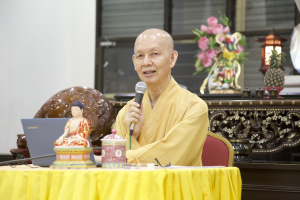
To say yes is to die
A lot or a little.
― Gwendolyn Brooks
In a world driven by choice, individual freedom, and the promise of endless possibilities, commitment can seem like a sacrifice. Yet, for those on a spiritual path, this paradox—between embracing freedom and staying committed—is not just a challenge but a gateway to deeper insight.
In my mid-30s, as a freshly ordained member of the Triratna Buddhist Order, I started to co-lead week-long retreats, mainly in Germany and the UK. Based around traditional Buddhist teachings, the retreats often entailed some experimentation, using voice, movement, and devised rituals. It felt important for this playfulness to be held in a solid container of collective practice so that the retreat could deepen in the balance of structure and freedom. As is the custom on beginner retreats, after a couple of days I’d give a pep-talk on the importance of commitment to the daily program and keeping the silence during the allocated periods. More often than not, I then sensed a change in the atmosphere, an uncomfortable distancing between me and the group, a disruption to the relaxed and warm flow that had been established. I’d bring it up in team meetings and gradually I came to learn a few things.
Firstly, there was a cultural element: I am German and what seemed to trigger people’s reactivity was, apparently, my tone of voice and choice of vocabulary in those situations. I had to adjust to the British way of approaching things more indirectly and softly, making it sound as if I wasn’t really saying anything. . . . It was also helpful to consider that the subject itself readily sparks reactivity. Even while seeing the benefits of commitment in terms of stability and belonging, people are edgy around their freedom potentially being curtailed and easily feel trapped. This may be particularly strong in the setting of a Buddhist retreat center, when the call for commitment can provoke anxieties about being confined to a singular path.
Gradually, some helpful strategies emerged, such as letting another, more soft-spoken team member give that spiel, and choosing a less top-down approach by exploring the subject in the context of a group discussion right at the start of the retreat. I might ask more experienced retreatants to share their experience of silence, while also giving anyone the opportunity to voice any worries. Acknowledging the importance of personal freedom and agency, and how that might express itself on a retreat was part of the conversation. We would arrive at a sense of collectively held commitment, which, to some extent at least, released me from the burden of carrying the responsibility and lessen the chances of being turned into “Aunt Sally”—a British tradition where people throw projectiles onto a doll at a fairground.
Thirty years on, the topic is as alive as ever, with a new and influential angle: the all-pervasive effect of consumer culture. With its emphasis on choice, instant gratification, and the search for the “next best thing,” it is harder to value and access the patience, tolerance of discomfort, and appreciation of long-term gain that are required for any spiritual endeavor. Fear of missing out (FOMO) on something better, fostered by constant comparison facilitated by social media, easily leads to a reluctance to commit to anything. Consumer culture promotes individualism and self-optimization, personal success, personal branding, and self-care, which can lead to devaluing commitment to groups and serving the benefit of others. Further, consumer culture’s focus on autonomy and self-sufficiency can make people wary of depending on others or being depended on. All of these influences make it difficult to embrace a nuanced, fluid form of commitment, in which the apparent dichotomies of personal and collective and short-term and long-term can be acknowledged and even embraced and understood in deepening ways.
The practice of meditation, with its emphasis on self-awareness, is potentially a learning platform that requires us to navigate sensitively between continuously attending to a specific focus or intention, while adjusting our approach in response to what arises from the wider field of experience. We get to know our forbidding inner task masters and fierce rebels, as well as wise and compassionate Selves that can navigate the discussion and come up with solutions that allow for deeper integration and inner harmony. Maybe, over time, our understanding matures to some extent and we can navigate the territory of commitment and freedom more gracefully. Thirty years on, I am running an eight-week mindfulness course and the attendance is quite variable. And yes, we did have that initial chat about group commitment. . . . I notice that the subject can still rouse strong emotions, which is probably why I choose to write about it. Initially, my writing voice was tinged by a degree of sternness, as if without some firmness nothing will be achieved. Not even non-achievement! The more I reflect on this matter, the more it becomes clear that what is most helpful in this arena is an attitude of open-ended exploration, letting go of the blinkered urgency to find a resolution. At the core of this apparent commitment/freedom dichotomy lies a paradox that carries the potential for a leap in Insight. Ultimately, they are not opposites—commitment leads to growth and liberation, and a great deal of flexibility is needed to prevent commitments from becoming static or stale. It can be a joyous process.
Brooks’s insight, “To say yes is to die a lot or a little,” speaks to the sacrifice inherent in every commitment. Whether it’s a meditation practice, a relationship, a group, or a project, saying “yes” often means saying “no” to other possibilities—a little death of our attachment to freedom or control. As our experience unfolds, we learn that commitment, paradoxically, can lead to greater freedom, not less. In this writing process, saying “yes” to the paradox inherent in the theme almost feels like a little death—of the part in me that craves certainty, linearity, and being in control. It makes room for a different way of being; one more subtly attuned to the flow of shifting needs, closer to what life is like.
At different times in our lives, in our social circles and during any meditation period, more discipline and commitment are required, and at other times, it serves us better to go easy and explore afresh what really matters to us. In social situations, this can easily lead to tension. For example, a friend of mine, who has recently retired from a successful career, finds that after decades of sacrificing her more immediate desires in the service of work and family, she now has a lower commitment threshold with regard to attending various groups, wanting to prioritize more spontaneity in her life. Another friend is about to start a new job that will absorb more of her time and energy, and she is beginning to withdraw from some commitments. This, of course, has an effect on others and leads to tension. For the people left behind there is an experience of loss, a weakening of the power of the collective. The willingness to embrace the paradoxical nature of the matter can help to explore this tension with openheartedness and to see it as a growth opportunity.

What do we want to commit ourselves to? For me, what comes to mind right now is to experience aliveness. I was struck by this passage in Sally Rooney’s Beautiful World, Where Are You? (Farrar, Straus and Giroux 2021). Eileen, one of the main characters rereads a “life book,” a personal diary of “good things” that she kept for a few months in her early 20s:
Walking around, even on a bad day, I would see things—I mean just the things that were in front of me. People’s faces, the weather, traffic. The smell of petrol from the garage, the feeling of being rained on, completely ordinary things. And in that even the bad days were good, because I felt them and remembered feeling them. There was something delicate about living like that—like I was an instrument and the world touched me and reverberated inside me. (p. 162)
The character in the novel finds it hard to reconnect with this freshness of experience—it seems to have been dependent on that student stage in her life when “anything was possible,” the future wide open. I found myself saying to Eileen: try meditation as a way to dwell in this open dimension more regularly. And it will require some commitment! Ultimately, the paradox of commitment and freedom is not something to resolve but to live into. Commitment, when approached with flexibility, leads to growth and deeper liberation. Perhaps it is in this very tension—between structure and spontaneity—that we find the richest insights, allowing our practice and our lives to unfold in new and joyous ways.
What is your experience with commitment? Please offer your feedback in the comments below.
References
Rooney, Sally. 2021. Beautiful World, Where Are You. New York: Farrar, Straus and Giroux.
Related features from BDG
Free Will and Freedom from Suffering
Book Review: The Power of Mind: A Tibetan Monk’s Guide to Finding Freedom in Every Challenge
Riding on the Back of Freedom: The Meaning of the Garuda
The Price of Freedom
Buddhist Thoughts on Freedom












